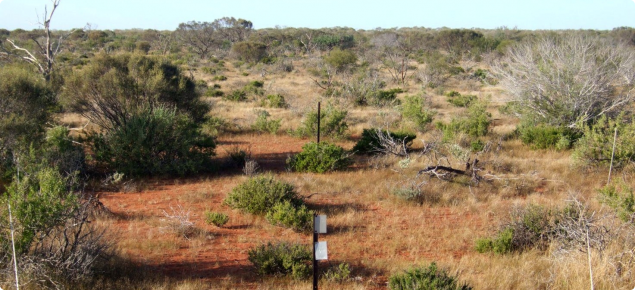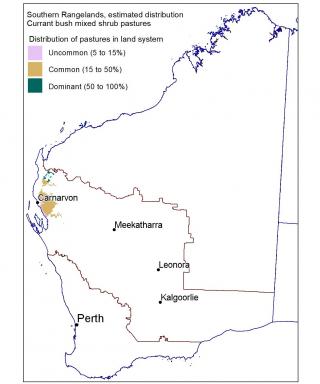Pastoral potential – high
The pastoral value of the currant bush mixed shrub pastures is high. Currant bush leaves contain up to 13% protein and are relished by stock. Pastures in good or fair condition support a broad range of palatable shrub species with excellent durability in dry times and there is an abundance of palatable annual species in season. When in good or fair condition pastoral value is high and the pastures are suitable for grazing on a year-long basis by all classes of stock.
Many currant bush mixed shrub pastures are degraded, with a loss of desirable species. Poor condition pastures will produce bulk annual species in good seasons, but durability is considerably reduced. Dramatic increases in undesirable shrubs such as needlebush, waxy leaf poverty bush, grey cassia and other cassia species have occurred in some parts, greatly reducing pastoral value to well below the potential.
Suggested levels of use (per annum)
Table 1 provides a rough guide to the range of pastoral values for good condition pastures, which must be checked against conditions in each region and paddock. Carrying capacities for fair condition pastures might be 75% to 50% of good, and poor condition pastures less than 50% of good.
See Introduction to pastures in the southern rangelands of Western Australia for an explanation of how carrying capacities are estimated.
| Condition | Carrying capacity ha/DSE1 | Carrying capacity ha/CU2 (ha/AE3) |
|---|---|---|
| Good | 5.1–9.9 | 36–69 (43–83) |
1 DSE is based on the feed energy required to maintain a 45 kilogram liveweight Merino wether with zero weight change, no wool growth additional to that included in maintenance, and walking 7 km/day. 1 DSE has an energy requirement of approximately 8.7 MJ ME/day.
2 CU in the southern rangelands is based on a 400 kg steer at maintenance and equivalent to 7 DSE.
3 AE is based on the feed energy to maintain a 450 kg Bos taurus steer 2.25 years of age, walking 7 kilometers each day. 1 AE has an energy requirement of approximately 73 MJ ME/day and equivalent to 8.4 DSE.
Management
Currant bush is capable of recolonising areas dominated by buffel grass, provided grazing pressure is not excessive and the area remains free from fire.
Erosion is uncommon even when the pastures are in poor or very poor condition. Minor to moderate water or wind erosion occurs locally in the form of an accumulation of wind-blown soil around plant bases (hummocking) or pedestalling with soil loss and scalding between shrubs.
Pasture condition
Survey data show that currant bush mixed shrub pastures in the southern rangelands are predominantly in fair to poor condition.
Good
See Figure 1. An abundance of palatable shrub species is present, and may include: green cassia, cottony saltbush, ruby saltbush, warty-leaf eremophila, Wilcox bush, flat leaf bluebush, felty leaf bluebush, currant bush, cotton bush, and tall saltbush. The distribution of these species is irregular and it would be rare for them all to be growing on the one site. The individual densities of such indicators are relatively low, but combined as a stand they provide significant dry season forage. Undesirable species only occur as scattered individuals within communities. No erosion is present.
Total shrub densities vary widely from 3000 to 5000/ha. Projected foliar cover (PFC) may range from 5 to 50%, but is usually between 20 and 25%.
Fair
See Figure 2. There is a partial, but obvious loss of the palatable species indicated above. The most palatable, preferentially browsed species such as green cassia, ruby saltbush and warty-leaf eremophila may be present only as large, old individuals. Other palatable species such as currant bush and tall saltbush are usually still present, but may show poor vigour and lack young plants. Seedlings and young plants of unpalatables such as needlebush and bardie bush may be prominent, especially in dry conditions when they are most visible. There is generally no erosion.
Total shrub densities are commonly around 3000/ha. PFC may range from less than 5 to 25%, but is commonly 10 to 15%.
Poor
See Figure 3. There is low species diversity and pastures are dominated by unpalatable species. Bardie bush, needlebush, waxy leaf poverty bush, grey cassia, silver poverty bush, tomato bush and other unpalatables can dominate. Palatable species are often absent, dead or exist only as occasional heavily browsed relics.
Total shrub densities may be higher or lower than when in good condition, averaging 2000/ha, depending upon species and individual plant size. PFC ranges from less than 5% to 50% depending on whether or not an invasion by undesirables has occurred. Cover levels of 20 to 25% are common (similar to good condition), but are provided by unpalatable rather than palatable species.
Currant bush mixed shrub pastures condition photographs
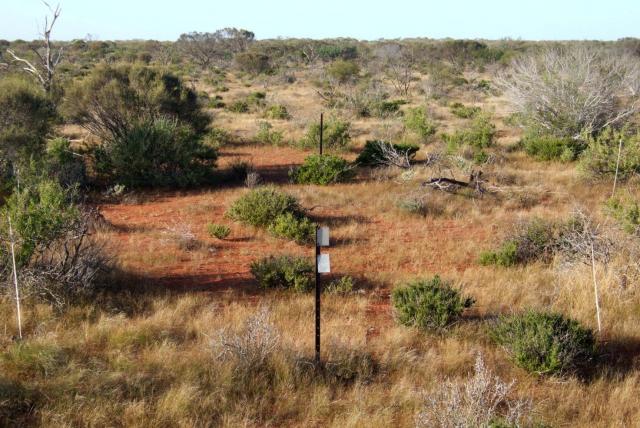
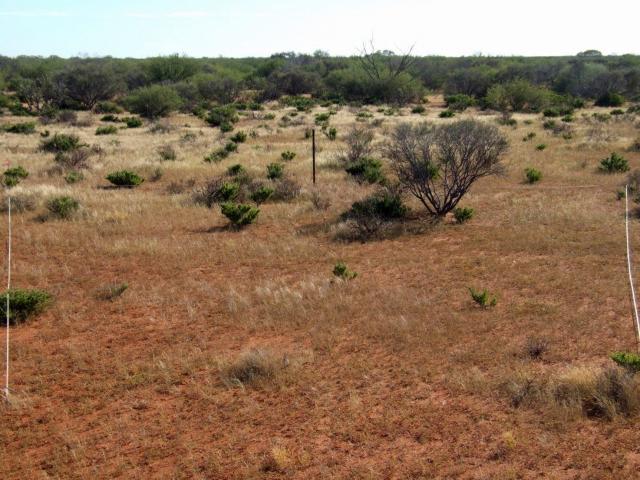
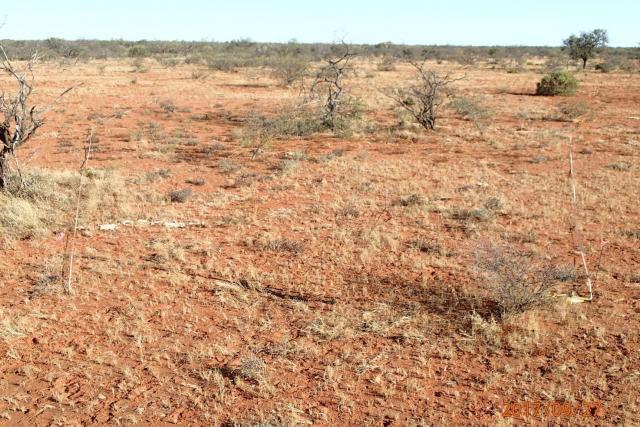
Vegetation structure and composition
Currant bush mixed shrub pastures are predominantly moderately close (PFC 20-30%) tall shrublands, dominated by Acacia, Eremophila and Senna species, with a diverse shrubs understorey. These pastures are characterised by currant bush, which can occur either as a low or tall shrub. Currant bush is a distinctive plant, named for its small black berries which grow singly on short stems along the branches. Currant bush grows 3 metres high in favourable, non-saline conditions.
There are spiny and less spiny currant bushes. Currant bushes with acute spines are not a useful indicator species for pasture condition. The Gascoyne coast currant bushes on the major river floodplains are either not spined or carry relatively short, mostly-single spines. In the stony uplands the spines are commonly acutely developed and much branched. The acutely spined ecotypes may expand to infestation proportions, particularly adjacent to stock water points. These weedier forms appear restricted to stony inland soils that are saline in some degree. ‘Weed proportion’ populations develop under heavy grazing pressure.
Other major tall shrubs include curara, bardie bush, needlebush, mingah bush and pebble bush. Total low shrub densities vary. Common low shrubs include grey cassia, cottony saltbush, ruby saltbush, waxy leaf poverty bush, turpentine, flat leaf bluebush, felty leaf bluebush, cotton bush, Gascoyne mulla mulla, tall saltbush and flannel bush. Perennial grasses are often absent, but may include erect kerosene grass, curly windmill grass and buffel grass.
Occurrence
Currant bush mixed shrub pastures are found in the Carnarvon Basin and adjacent upper Gascoyne and cover an estimated 0.41 million hectares (0.5% of the southern rangelands) These pastures often grow in combination with sandplain acacia pastures. They are common on alluvial soils, including salt lake tributary areas, and less frequently on rocky slopes, hardpan plains, sandbanks and sandplains.
Associated plants
| Common name | Scientific name (links to FloraBase) | Desirability* |
|---|---|---|
| Buffel grass | Cenchrus ciliaris (alien) | D |
| Climbing mulla mulla | Ptilotus divaricatus | D |
| Cotton bush | Ptilotus obovatus | D |
| Currant bush | Scaevola spinescens | D |
| Curly windmill grass | Enteropogon ramosus | D |
| Felty leaf bluebush | Maireana tomentosa | D |
| Gascoyne bluebush | Maireana polypterygia | D |
| Green cassia | Senna glutinosa subsp. chatelainiana | D |
| Horse mulla mulla | Ptilotus schwartzii | D |
| Mingah bush, bullock bush | Alectryon oleifolius | D |
| Ruby saltbush | Enchylaena tomentosa | D |
| Silver saltbush | Atriplex bunburyana | D |
| Split leaf buttercup bush | Senna charlesiana | D |
| Tall saltbush | Rhagodia eremaea | D |
| Warty-leaf eremophila | Eremophila latrobei | D |
| Wilcox bush | Eremophila forrestii | D |
| Bardie bush | U | |
| Bloodbush | Senna artemisioides subsp. oligophylla | U |
| Crinkle leaf cassia | Senna artemisioides subsp. helmsii | U |
| Grey cassia, desert cassia | Senna artemisioides subsp. x coriacea | U |
| Erect kerosene grass | Aristida holathera | U |
| Needlebush | Hakea preissii | U |
| Royal poverty bush | Eremophila cuneifolia | U |
| Shark Bay poverty bush | Eremophila maitlandii | U |
| Silver poverty bush | Eremophila pterocarpa | U |
| Straight leaf cassia, variable cassia | Senna artemisioides subsp. x sturtii | U |
| Tomato bush | Solanum orbiculatum | U |
| Turpentine bush | Eremophila fraseri | U |
| Waxy leaf poverty bush | Eremophila crenulata | U |
| Curara | Acacia tetragonophylla | I |
| Flannel bush | Solanum lasiophyllum | I |
| Gascoyne mulla mulla | Ptilotus polakii | I |
| Limestone wattle | Acacia sclerosperma | I |
| Pebble bush | Stylobasium spathulatum | I |
| Cottony saltbush | Chenopodium gaudichaudianum | I |
| Snakewood | Acacia xiphophylla | I |
| Perennial tar vine | Commicarpus australis | N |
* D = desirable, U = undesirable, I = intermediate, N = no indicator value

